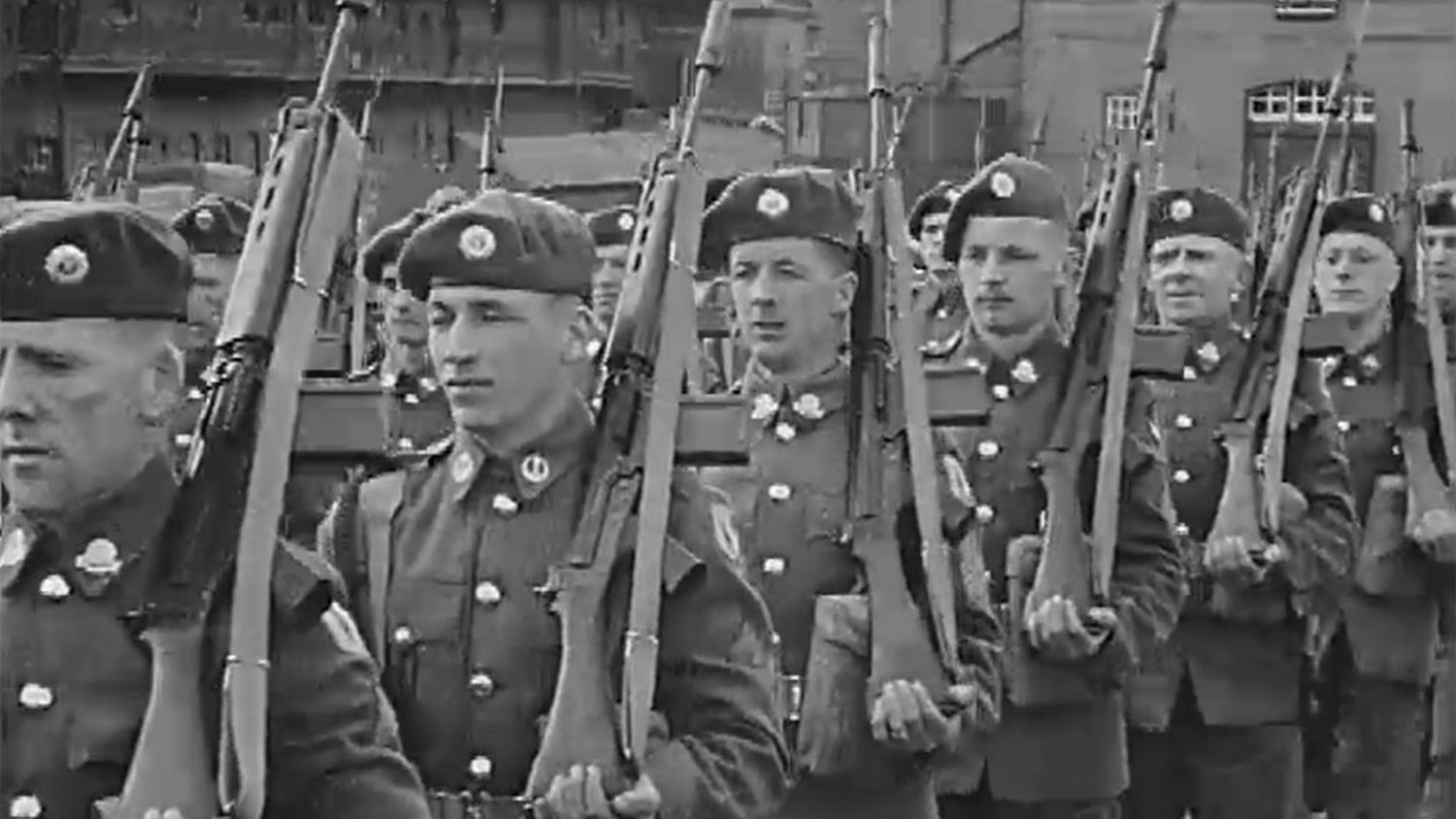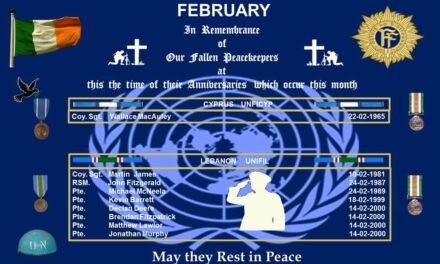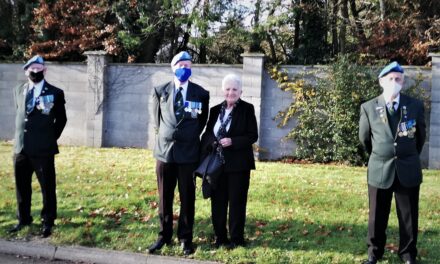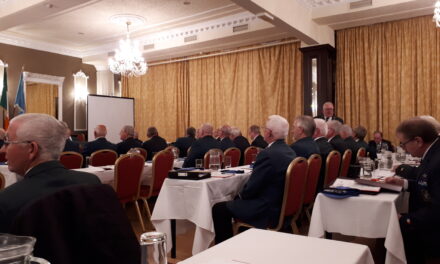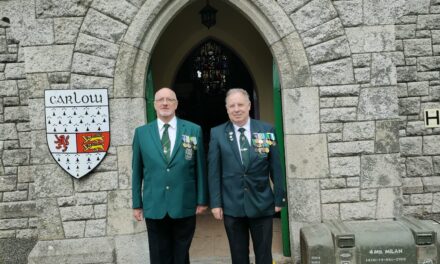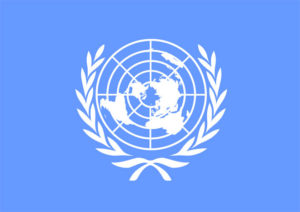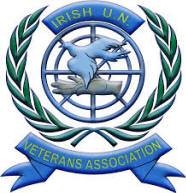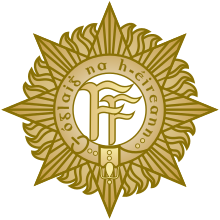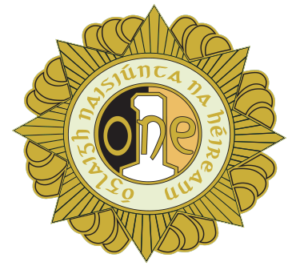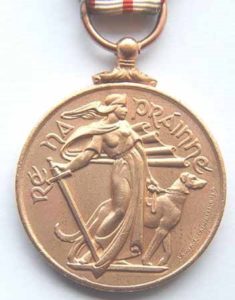
There were 11 different types of medal issued for service during The Emergency. The front of each medal was the same design with the back having different text for each of the different organisations who rendered service during the War.

The text used on the back of the medal was old Gaelic script. Because very few keyboards have keys to represent this script this text shows the translation from the Old Gaelic Script to modern English letters.
26ú Cathlan
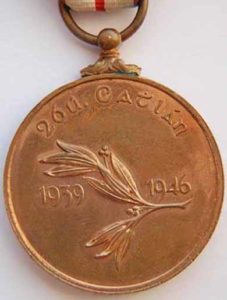
Although this medal is usually claimed to have been awarded to Veterans of the 1916 Rising, War of Independence and Irish Civil War the structure of the FCA included Regiments or Battalions representing The 1798 Rebellion, Fenian Risings, 1916 Rising and the War of Independence.
- 11ú Risimint Marcra(Cavalry Regiment) 1798 Group.
- 41ú CathlanFenian Group.
- 26ú Cathlan1916 Group.
- 42ú Cathlan1920 Volunteer Group.
The 26ú Cathlan was probably the only Battalion to reach battalion strength although the other groups survived, in name at least, up until the late 1950s and early 1960s. Numbers for the 26ú range from as low as 800 up to as many as nearly 2,500.
Na Forsai Cosanta
Awarded to members of the regular Army Navy and Air Corps for 1 year service, a 1939-1946 service bar was added for each further 2 years service up to a maximum of 2 service bars.
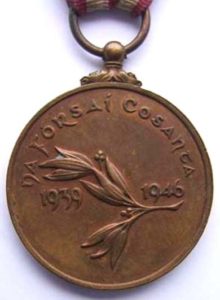
An Forsa Cosanta Aitiuil
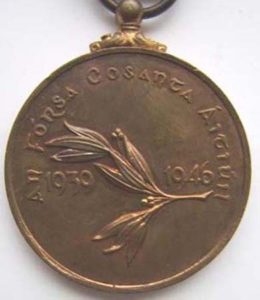
The reserve defence forces. Known as the Local Defence Force abbreviated to LDF also FCA after the initials of Forsa Cosanta Aitiuil. A part time force set up to take the place of the regular army when required. The medal was awarded for 2 years service with a 1939-1946 service bar add for each further 2 years of service up to a maximum of 2 bars. The earlier issue of this medal had a ribbon with a single white stripe which was later changed to a double white stripe.
L.D.F. or F.C.A. Badge
This badge was worn by members of the local defence force when they were not in uniform. The outer sunburst design is similar to the Irish Army cap badge and the L.D.F. initials in the centre are similar to the Gaelic script used on the medal.
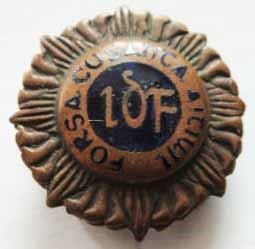
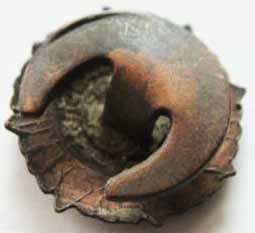
This badge was worn on the coat or jacket attached using the half-moon type attachment as seen in the image, the badge was also available with a pin fixing.
An Caomnoiri Aitiula
The Local Security Force, usually abbreviated to LSF. Set up under control of the Garda (Irish Police Force) it was responsible for local security and its duties included replacing members of the Garda when required, monitoring Irish Republican Activity (IRA) and assisting the Garda in maintaining law and order. Many full time Garda were members of the LSF. The medal was awarded for 2 years service with a 1939-1946 service bar add for each further 2 years of service up to a maximum of 2 bars. Although members of this force were supposed to be uniformed and armed issue of uniform and arms varied greatly for region to region.
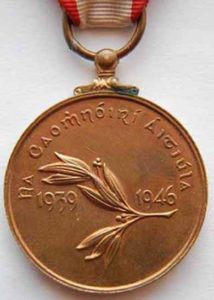
L.S.F. Badge
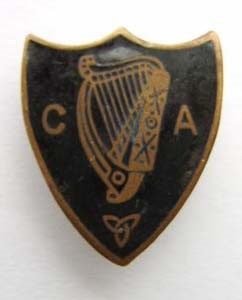
Members of the LSF were issued with a badge to show they were members. The badge was to be worn where uniform was not appropriate or while a member was waiting for their uniform to be issued to them. Because of the nature of some of the operations the LSF took part in, such as surveillance of an IRA suspect, uniform would not be appropriate.
I have seen these badges offered on Ebay as 1916 Rising Citizen Army badges, the C A is an abbreviation of Caomnoiri Aitiula. The badge has no connection what so ever with either the 1916 Rising or the Citizen Army.
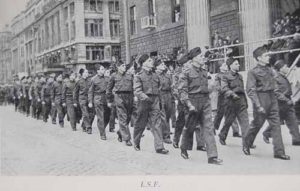
Members also wore various armbands and badges to show rank or the various sections they belonged to.
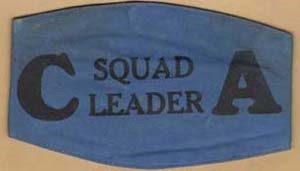
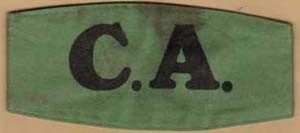
Patch worn on the shoulder of the uniform to denote service with the Communications Section.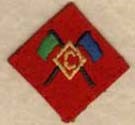
Patch worn on the shoulder of the uniform to denote service with the First Aid Section.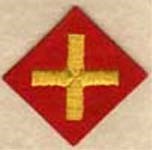
Patch worn on the shoulder of the uniform to denote service with the Protective Measures Section.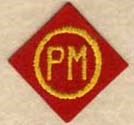
Patch worn on the shoulder of the uniform to denote service with the Traffic Section.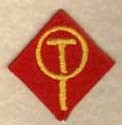
Patch worn on the shoulder of the uniform to denote service with the Transport Section.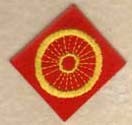
Na Seirbhise Reamhcuraim in Aghaidh Aer-Ruathar
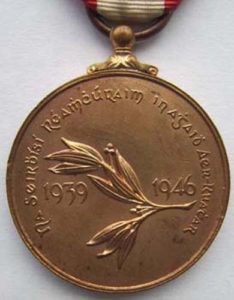
Abbreviated to ARP, members did not wear uniform but wore an armband denoting they were members of the ARP. There were several bombing raids carried out by the Germany Air Force on the Republic of Ireland during the Second World War. ARP duties were to enforce black-out regulations. The medal was awarded for 2 years service with a service bar added for each additional period of 2 years service up to a maximum of 2 bars.
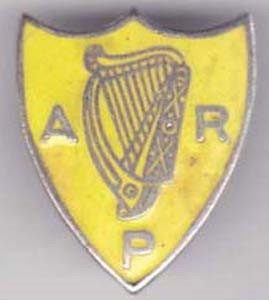
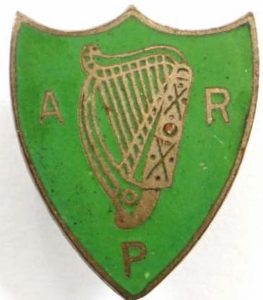
As members of the ARP did not wear uniform members were issued with a badge and an armband to show they were part of the ARP service. The badge was worn on the lapel. I have seen the ARP badge in a variety of different colours including green, red, white, purple and blue.
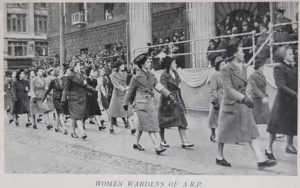
The ARP was one of the Emergency units which women were allowed to join. The images above show women of the ARP marching passed the reviewing stand and the 25th Anniversary of the 1916 Rising parade held in Dublin in 1941.
An Slua Muiri
Also known as the Marine Inscription which derives from an old French system of having a list of sailors available to take the place of regular naval personnel if required. Members wore uniform, see image below, and were armed. The medal was awarded for 2 years service with a service bar added for each additional period of 2 years service up to a maximum of 2 bars.
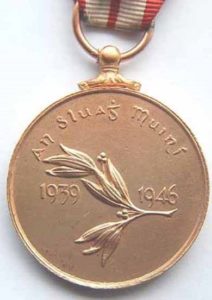
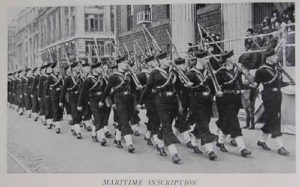
Forsa na Noglach 2u Line
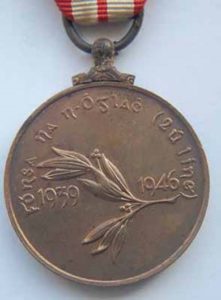
The Second Line Reserve. Made up of men of mature years this force was to replace reserves call-up for full-time duties. This force consisted of experienced military, medical and engineering staff usually with past service with the Irish or British armies
Ranna Cead-Cabhrac Cumann Croise Deirge na h-Eireann
First Aid Division, Irish Red Cross, also known as the Military Red Cross, these members served the Permanent and Reserve Defence Forces. The medal was awarded for 2 years service with a service bar added for each additional period of 2 years service up to a maximum of 2 bars.
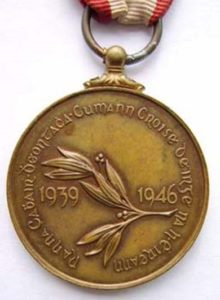
Ranna Cabhair Deontaca Cumann Croise Deirge na h-Eireann
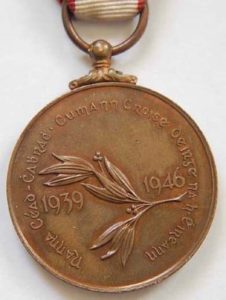
Volunteer Aid Division of the Irish Red Cross, also know as the Civilian Red Cross, served the general public. The medal was awarded for 2 years service with a service bar added for each additional period of 2 years service up to a maximum of 2 bars.
SEIRBHIS ALTRANAIS AN AIRM
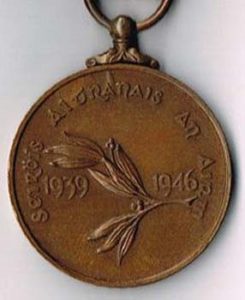
During the Emergency there were 7 Military hospitals in Ireland:
- Saint Bricins Military Hospital Dublin
- Military Hospital Curragh Camp
- Military Hospital Haulbowline
- Saint Mobhis in the Phoenix Park Dublin
- New hospitals in Mallow and Ballinasloe
- Saint Enda’s Galway.
The highest estimate of serving nurses during the emergency I have seen is 550. Nurses were not members of the defence forces but attached to the defence forces because as the majority of nurses were women and the Irish Defense Forces did not admit women until 1982.
AN SEIRBHIS SEIPLINEACHT
The smallest amounts of Emergency service medals were issued to the Chaplaincy Service (AN SEIRBHIS SEIPLINEACHT). The highest number I have seen this issue numbered at was 67 and this was in what looked to be a well researched article, in the Irish Medal Society Journal.
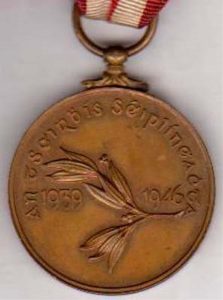
Service Certificates
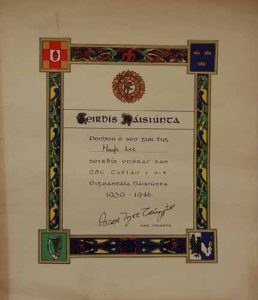
Persons who had served but who had not reached the required service time to receive a medal were awarded a Certificate of Service.
Each certificated had the name of the organisation the recipient served with on it, the certificate on the right was awarded to a member of 26ú Cathlan. There were two types of certificate, Regular Army and other armed services received a cert with the Irish Army crest while non-military organisations such as the Red Cross had a harp instead of the Army crest.
Certificates were issued un-named with space provided for the recipient to add their name if they so desired.
Issue Box and Compliments Slip
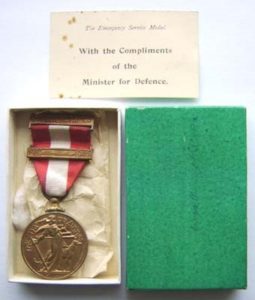
Irish Merchant Navy Medal
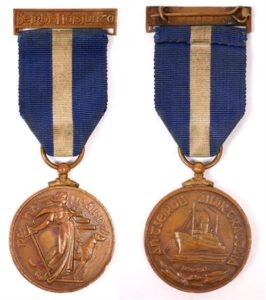
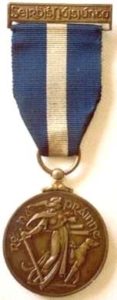
The Merchant Navy Medal was awarded to those who served in the Irish Merchant Navy during the Emergency period. The front of the medal disc is the same design as all the other Emergency medals but the back had a different design. The medal was awarded to Merchant Navy personnel only. Numbers of medals issued were:
- Medals without bar 299
- With one Bar 122
- With two Bars 34
- With three Bars 58
- Certificates 40
The medal also differs from other Emergency medals as it was issued with a blue and white ribbon and it could also be awarded with three 1939 – 46 service bars where as the other emergency medals could only be awarded with a maximum of two bars. The qualifying period for receipt of the medal was 3rd September 1939 to the 31st March 1946 with a minimum of 6 months served. The recipient must have served on a ship which was registered in Ireland, fishermen who served on deep-sea trawlers also qualified for the medal.
The recipient received their medal in a green cardboard box with a complement slip The Emergency Service medal With the complements of the Minister of Defence was printed on the slip.
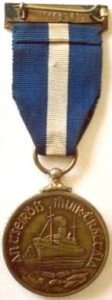
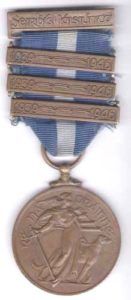
The 1939-1946 bars on the Merchant Marine medal are identical to those on all the other emergency medals. It is more common to see these medals with 3 bars rather than 2 or 1 because over the years dealers have added bars to the maximum amount to try an increase the value of the medal, tell tale signs of this practice can be see in the medal opposite where the edges of the ribbon are tatty and frayed.
The sinking of the Kyleclare
The Limerick Steamship Companies vessel Kyleclare was torpedoed and sunk by the German submarine U-456 whilst about 100 miles west of the mouth of the River Douro, Portugal on the 23rd of February 1943. Eighteen men, including the Captain were drowned. The Commander of the U-456, Kapitan Leutnant Max Teichert, later claimed that he could not see the Kyleclare’s neutral markings as she was low in the water, listing to starboard and his periscope was awash. Just a few weeks later the U-456 was herself sunk in mid-Atlantic by a Canadian escort vessel, there were no survivors.
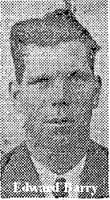
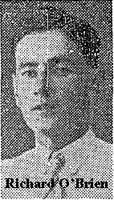
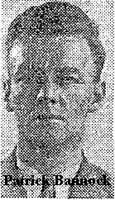
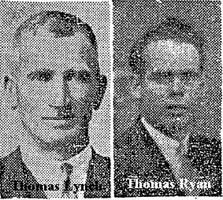
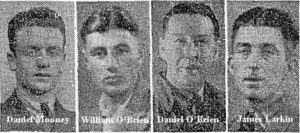
- Alan R. Hamilton master/captain of the vessel. He was 55 years old married and from Daly’s Fort Road, Salthill County Galway. He first went to sea at the age of 15 and served in the Royal nave as Lieutenant in the Reserve of Officers. He was in charge of the Galway Maritime Inscription since its formation.
- Patrick Bannock, Able Seaman, aged 38, single, from Pigeon House Road, Dublin.
- Edward Barry, Able Seaman, aged 32, married from Streamstown, Tagoat, Wexford.
- Thomas Brady second engineer, aged 54, married, from New Road Galway.
- Diarmuid de Burca, First mate aged 29, married and from Raglan Road, Dublin.
- Richard Grimes, Cook, aged 57, married, from Bolton Street Dublin (Photo)
- Philip Hopkins, Bo’sun aged 42, widower from Pigeon House Road Dublin.
- John Larkin, Fireman, aged 28, married, from Seville Place, Dublin.
- T Lynch, Able Seaman, aged 51, married from Main Street, Clogher Head, Louth.
- John Morgan, Fireman, aged 36, married from Newmarket Street, Dublin
- Daniel Mooney, Sailor, aged 24, single, from Oak Road, Donnycarney Dublin
- William O’Brien, Firemand, aged 25, married, from Pearse Street, Dublin. Brother of Richard O’Brine died in the same incident.
- Richard O’Brien, Able Seaman, aged 24, single, from Lower Mayor Street, Dublin. Brother of W. O’Brine died in the same incident.
- Daniel O’Brien, Steward, aged 57, married, from Botanis Avenue, Glasnevin, Dublin
- P O’Neill, Fireman, aged 24, single, from Cumberland Street, Dun laoghaire, County Dublin
- Thomas Ryan, Donkeyman, aged 42, married, from Hayestown, Rush, County Dublin.
- William J Simms aged 61, married from Donadea County Kildare.
- Ultan Tobin Second Mate, aged 21, single a native of Enniscorthy County Wexford he lived at Brookville County Dublin.
The medal suspension pin broach and service bars were the same for all Emergency Medals including the merchant marine medals.
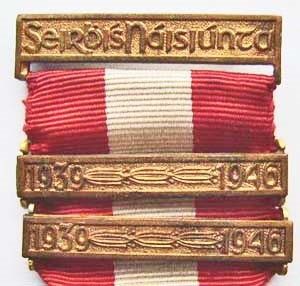
Identity Cards
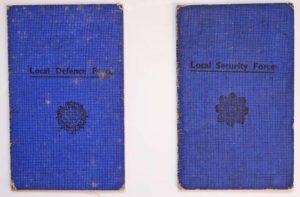
An identity card was issued to a member of each force, the LSF had the Garda badge on the front and the FCA had the Army badge. It wasn’t unusual for someone to have been a member of more than one of the auxiliary forces and qualify for two medals. In the case of these two ID card John Doherty joined the LSF on the 2nd of August 1940 transferring to the FCA on the 12th of February 1943.
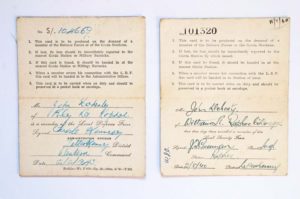
Having served 2 and a half years with the LSF John Doherty would have qualified for an LSF medal with no extra bars. His service with the FCA ceased on the 27th of July 1946, having served over three years with the FCA he would have qualified for an FCA medal with one bar.
Numbers of Emergency Medals Issued
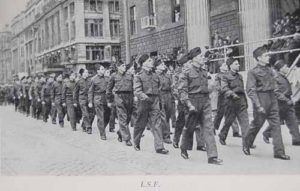
There are no official records of the number of medals issued for services rendered during the WW2 period. The popular belief in the medal collecting community is that the An Caomnoiri Aitiula (Local Security Force) medal is the most common. When the formation of the LSF is researched it shows that this would tend not to be the case.
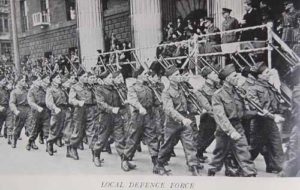
Ireland declared a State of Emergency in September 1939, responsibility for military and civil reserves was under the control of The Volunteer Reserve which had been formed in 1929. In June 1940 the Volunteer reserve was renamed the Local Security Force (LSF). The “Emergency Powers Order” gave official authority for the establishment of this force and was described in Article 54 of this Order as the “Temporary Special Police Force.” This Force, incorporating a Defence Force and a Police Force with the role of securing Ireland’s 26 counties was created from a network of volunteers in every locality who carried out local security duties and reported any hostility to the Force’s controlling authority, An Garda Síochána.
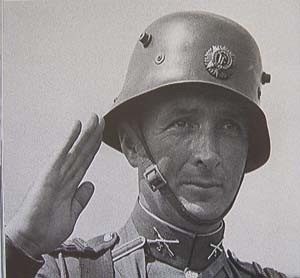
The LSF was under control of An Garda Síochána and was split into a number of different groups with responsibility for Communications, Transport, Engineer, Supply, First Aid and a Combat Group. After a nation wide recruitment campaign within three month numbers in the LSF had grown to over 180,000. The majority had volunteered to join the Combat Group which had the responsibility to defend installations of public importance such as Power Stations, Water Works and Fuel Depots. Although I think the main attraction of the Combat Group was that its members could carry arms.
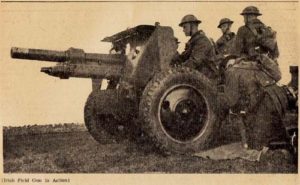
By August 1940 the LSF numbered 148,306 and by January 1941 the LSF had grown to such a size it was becoming un-manageable for the local Garda. It was decided that the LSF would be split into Group A and Group B. Group A (the largest) would come under the control of the Army while Group B remained under the control of An Garda Síochána. Group A contained the Combat Group and it was felt the Army could offer more training in armed combat and as members carried arms it was felt military discipline was also necessary.
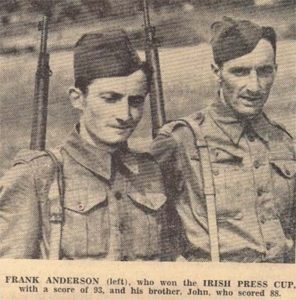
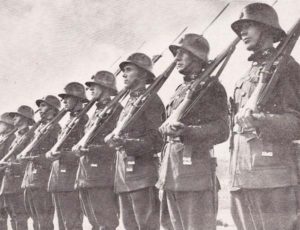
Although made by Vickers a UK based company the style of helmet was often referred to as German or Coal Scuttle helmet. This style of helmet was worn as part of the Irish Defence battle dress between 1928 to 1938.
Allied Medals Issued to Irish People
Although Ireland did not take an active military part in World War 2, the 26 counties of Ireland remained neutral through the war, it is possible to collect medals awarded to Irish men and women who served with the Allied forces during hostilities. Irish men and women from the armies of the United Kingdom and many of the countries of the Commonwealth fought in all theatres of WW2.
It is difficult to research medals awarded to soldiers who fought in WW2 but it is possible. Probably the easiest way to get information on the recipients of the medals is too get it with the medals. If the recipient’s records are not with the medal then it is necessary to search the archives of the country for which they served, as the records are not available online it would be necessary to go to that country to do the research.
Because Ireland did not gain independence until 1922 the majority of Irish people over 17 years old in 1939 were born under English rule and could claim British citizenship that is why when researching the records of Irish people who served in the forces of the Commonwealth during WW2 their nationality is often given as British.
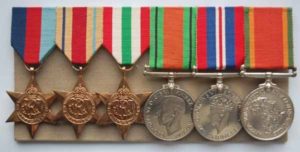
The medals above, a group of 6 to an Irishman, who served in the Southern Rhodesia Armoured Car Regiment, attached South African Signals, and member of the Southern Rhodesia “Victory Contingent” in London, 1946 (Private A.E. Clanchy, late Southern Rhodesia Armoured Car Regiment)
- 1939-45 Star
- Africa Star
- Italy Star
- Defence Medal
- War Medal
- Africa Service Medal 1939-45 (SR. 597726 A. E. Clanchy)


Arthur Edward Clanchy, who was born in Kilkenny, Ireland in May 1905, attested for the Southern Rhodesian Forces at Umtali in August 1940, and was embarked for Egypt as a member of the 11th Division, Rhodesia Reconnaissance Unit, in February 1941 – that August he joined the strength of the Armoured Car Regiment in the rank of Acting Sergeant. Transferring to the Union Defence Force (U.D.F.) in December 1942, he qualified as a Wireless Operator and was posted to the S.A. Corps of Signals, in which capacity he witnessed further active service in the Middle East and Italy with No. 7 Company, S.A.C.S., before returning to Durban in October 1945. Clanchy, who was a member of the Southern Rhodesia “Victory Contingent” in London in 1946, died in May 1993.
Note: Per the naming conventions in Southern Rhodesia, the only officially named WW2 campaign medal was the Africa Service Medal, with unique Southern Rhodesia prefix.
Curragh Camp Coins
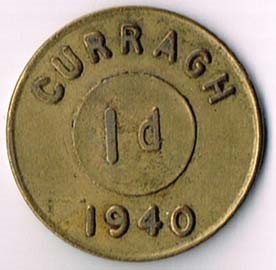
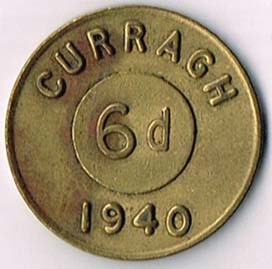
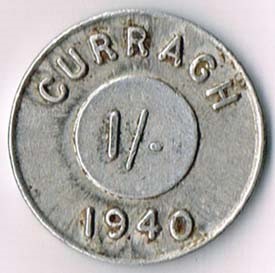
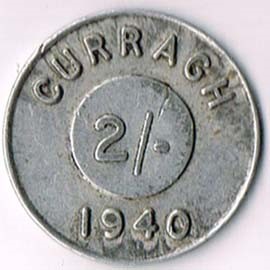
Coins used in the Curragh Camp County Kildare during World War 2. The coins were used as currency in the camp by detainees.

